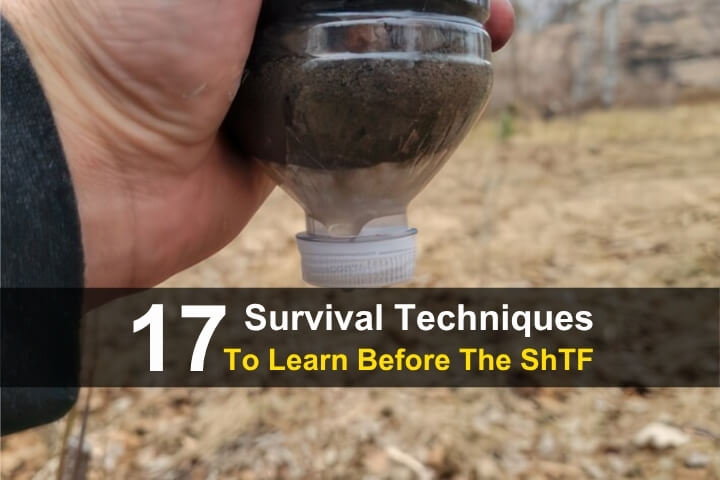Estimated reading time: 10 minutes

When the next disaster strikes, whether it’s a hurricane, an economic collapse, or a full-blown war, your fancy gear and high-tech gadgets might not save you. Especially if they’re lost or destroyed by something like an EMP.
What will save you? The knowledge in your head. I’m talking about time-tested survival techniques that have worked for generations. Some of them are centuries old and have stood the test of time because they work, plain and simple.
Want to save this post for later? Click Here to Pin It On Pinterest!
There are hundreds of survival techniques, but for this article, we cover 17 that could be especially useful when the SHTF. Most of these are surprisingly simple and require no special training. A few take practice, but all of them can make a real difference in a crisis. I broke them down into the following categories:
Fire & Heat
The Dakota Fire Hole

This is a stealth fire pit that reduces smoke and visibility and gets the most out of your firewood. You dig two holes connected by a tunnel, one for fire and one for air flow. It burns hotter, uses less wood, and stays mostly concealed in case you don’t want to draw attention. It’s also ideal for windy days.
Here’s how to do it.
Vaseline-Soaked Cotton Balls
If you’ve ever had trouble getting a fire going, you need to try this. All you have to do is mix some cotton balls with Vaseline. They light up with a single spark and will burn for several minutes, giving you time to get some wood burning.
Better yet, get some large plastic straws and cut them into short pieces, roll up bits of the Vaseline-soaked cotton and shove them inside each piece. After that seal them up using pliers and a lighter. Then you’ll have a bunch of waterproof fire starters!
I have a big Ziploc bag full of these and always grab a handful before going camping. I also have some of them in my bug out bag.
Here’s how to make them.
Water Collection & Purification
Solar Still for Collecting Water
If you’re in a dry area and there’s no fresh water nearby, you can collect some with a solar still. The concept is simple. You dig a large hole and place a container in the center, then you surround the container with vegetation and/or moist soil. Cover the hole with plastic (use rocks or dirt to hold it in place) and place a rock on the plastic, directly above the container.
Over time, the moisture from the vegetation will produce condensation on the underside of the plastic, which will move to the lowest part (where the rock in the center is pushing it down) and drip into the container. It’s slow, but if you create a bunch of these, they will produce water every day, possibly up to 3 or 4 cups each if you’re in a humid area.
DIY Charcoal and Sand Filter

If you don’t have access to a water filter, you can make a basic one using things like sand, charcoal, and gravel layered inside a plastic bottle. As water passes through, the materials help trap sediment and some impurities, improving both clarity and taste. You’ll still need to boil the water before drinking it, but this method will remove a lot of impurities and make the water taste much better.
Here’s how to make one.
Shelter and Protection
Debris Hut Construction

If you’re stranded outdoors and don’t have any kind of shelter, a debris hut is a lifesaver. Build a simple frame from sticks, cover it with leaves, pine needles, or other forest debris for insulation, and leave a small opening for entry. It retains body heat well and works in most environments.
Here’s how to build one.
Using Natural Windbreaks for Shelter

If possible, build your shelter behind a natural windbreak like a rock, a fallen tree, dense brush, or a hill. This will dramatically improve your comfort and safety. Blocking the wind will keep you warmer, make fire easier to manage, and protect your shelter from collapsing in high winds.
Here are 10 natural survival shelters to look for in the wild.
Food Acquisition and Preservation
Constructing a Simple Fish Trap
If you’re near a stream, lake, or pond, a primitive fish trap can catch food with minimal effort. You can build a basic funnel trap using sticks, rocks, or even a plastic bottle. Anything that allows fish to enter but makes it hard for them to escape. Set it in a shallow, slow-moving area and bait it with insects or food scraps. This method is easy and works really well.
Making a Simple Pemmican or Survival Fat Ball

Pemmican is an ancient survival food made from dried meat, rendered fat, and sometimes dried berries. It’s calorie-dense, shelf-stable, and doesn’t need to be refrigerated.
If you’re preserving meat in the field, mixing it with fat creates a compact, long-lasting ration that gives you plenty of protein and energy. It takes a bit of prep, but the result is a food source that stores well and provides a lot of calories.
Here’s how to make pemmican.
Navigation and Signaling
Using the Sun and Shadows to Find Direction

Even without a compass, you can easily estimate directions using the sun. All you need is a stick and a couple of rocks. This is called the shadow stick method. Place a stick upright in the ground, place a rock on the tip of the shadow, wait 15–30 minutes, then place another rock on the tip of the shadow. Draw a line between the two rocks, and that’s your east-west line.
Navigating with the Stars (Using the North Star)

At night, you can find true north using the North Star. First, locate the Big Dipper constellation. The two outer stars of the “bowl” point in a straight line to the North Star, which sits at the end of the Little Dipper’s handle. Once you’ve found it, you’ll know the direction of true north. It’s a timeless method that works without any gear, as long as the sky is clear.
Medical and First Aid
Improvising a Tourniquet
Severe bleeding can kill in minutes. If you don’t have a tourniquet, you can make one using a belt, bandana, or strip of cloth and a stick for twisting. Place it 2 to 3 inches above the wound and tighten it until the bleeding stops. Also note the time it was applied. Only do this as a last resort to stop someone from bleeding to death.
Treating Wounds with Sugar or Honey
If you don’t have any antibiotics or antibiotic ointment, sugar and honey can help as they both have natural antibacterial properties. Clean the wound, sprinkle granulated sugar (or apply honey) directly onto it, and cover it with a clean dressing. This can help prevent infection and promote healing when antibiotics aren’t available.
Self-Defense and Security
Creating a Perimeter Alert System

You don’t need electronics to set up a basic early warning system around your camp. Use fishing line or paracord strung at ankle height with noise-makers like cans, bells, or glass bottles. If someone (or something) trips the line, you’ll hear it. It’s simple, cheap, and effective.
Here are 6 DIY trip wire alarms.
Building a Hidden Cache for Emergency Supplies

In any collapse scenario, theft and desperation can become major threats. One way to protect your gear is to create a hidden cache near your home, bug out location, or along your evacuation route.
Use a waterproof container (like a PVC tube or ammo can) to store essentials like food, water, first aid, cash, or a backup weapon, and bury or conceal it in a place only you or your group knows about. This gives you a fallback option if your main supplies are lost or stolen.
Here’s how to create a survival cache.
Making Cordage from Natural Materials
When paracord runs out, knowing how to make rope from plants can be a game-changer. Use inner bark from trees like basswood, strips of yucca leaves, or even plastic bags. Twist two strands together in opposite directions to create strong, flexible cordage for tying shelters, traps, or gear.
Improvising a Fishing Kit
With just a soda can tab (hook), some thread or dental floss (line), and bait, you can make a basic fishing rig. Add a stick and you’ve got a working fishing pole. Knowing how to scavenge or improvise gear from trash or natural materials can provide food with little effort.
Building a Rocket Stove for Efficient Cooking

A rocket stove is a compact, fuel-efficient device that burns small sticks or twigs with little smoke. You can build one using bricks, metal cans, or even cinder blocks. The design channels air efficiently, so it burns hotter and cleaner than a regular open fire. It’s great for cooking meals while conserving fuel.
Here are 11 ways to make a rocket stove.
Like this post? Don’t Forget to Pin It On Pinterest!
You May Also Like:
Read the full article here






